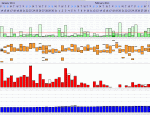What kind of patient needs straight pressure?
What kind of patient needs straight pressure?
When I first started xPAP therapy the doc told the DME to set my machine to straight pressure, not to any AUTO setting at all. I am thinking he saw something in sleep study.
What kind of breathing problems are better treated by straight pressure rather than setting a machine on Auto? I can guess that some people might have the pressure go too high and cause a central, I do not think that is the case for me, I seem to exhale easily against any pressure I have.
I do know that when I wake up at night, I look at the digital readout (My setting is auto 14 to 18) and it is nearly always on 14. I look at the ninety percent average (over four days) and it says I average 15 or 15.1. Which is curious. When the my machine settings were auto 13 to 18, it would average just above 14, which is why I changed it.
I guess if I had the money, I could buy a recording pulse oximeter and write down times when I wake and compare the charts in the morning. This points to the aggravation of our machines not having built into them a recording pulse oximeter recording, where we only need to get the part that goes on the finger and a cable to increase our data for analysis.
My basic question is, What kind of patient, breathing problem does better on straight pressure as opposed to having the machine set to auto?
What kind of breathing problems are better treated by straight pressure rather than setting a machine on Auto? I can guess that some people might have the pressure go too high and cause a central, I do not think that is the case for me, I seem to exhale easily against any pressure I have.
I do know that when I wake up at night, I look at the digital readout (My setting is auto 14 to 18) and it is nearly always on 14. I look at the ninety percent average (over four days) and it says I average 15 or 15.1. Which is curious. When the my machine settings were auto 13 to 18, it would average just above 14, which is why I changed it.
I guess if I had the money, I could buy a recording pulse oximeter and write down times when I wake and compare the charts in the morning. This points to the aggravation of our machines not having built into them a recording pulse oximeter recording, where we only need to get the part that goes on the finger and a cable to increase our data for analysis.
My basic question is, What kind of patient, breathing problem does better on straight pressure as opposed to having the machine set to auto?
_________________
| Mask: FitLife Total Face CPAP Mask with Headgear |
| Humidifier: S9™ Series H5i™ Heated Humidifier with Climate Control |
| Additional Comments: |
Re: What kind of patient needs straight pressure?
I can't imagine there is any reason to have it not on auto. Auto would act just like straight pressure if it needed to. I'm not a doctor but your machine should have a lower bottom pressure on auto and you should slowly creep it up as you look at the data. My machine is set to 7 to 15. This is because I had it wide open at first and looked at the data and I was never below a 7 but occasionally dropped there and never above a 15 but occasionally got close to there. Tightening the window helps and you don't want the low side to be below a 5 as that will make you feel like you are not getting a full breath but having a low side that high doesn't make sense to me. The machine will adjust to what its needs to there is no reason to have such a restrictive window I don't think.
- Lizistired
- Posts: 2835
- Joined: Tue Dec 14, 2010 10:47 pm
- Location: Indiana
Re: What kind of patient needs straight pressure?
We are all different. When I try auto, the pressure goes up higher than I need on cpap with no improvement in my AHI. My titration said 7, I use 7.8 or 8, and on auto I got up to 9.6 and had aerophagia. So I went back to cpap. My 9 month AHI average is 0.5 so I don't worry about why.
_________________
| Humidifier: S9™ Series H5i™ Heated Humidifier with Climate Control |
| Additional Comments: Swift FX sometimes, CMS-50F, Cervical collar sometimes, White noise, Zeo... I'm not well, but I'm better. |
ResScan: http://www.resmed.com/int/assets/html/s ... c=patients
ResScan Tutorial- http://montfordhouse.com/cpap/resscan_tutorial/
Machines Video: http://www.cpaplibrary.com/machine-education
ResScan Tutorial- http://montfordhouse.com/cpap/resscan_tutorial/
Machines Video: http://www.cpaplibrary.com/machine-education
- Sheriff Buford
- Posts: 4111
- Joined: Mon Aug 09, 2010 8:01 am
- Location: Kingwood, Texas
Re: What kind of patient needs straight pressure?
There has been a lot of threads concerning this lately. Do a search. Since it appears you have been on cpap therapy a long time, I suggest you find a straight cpap pressure (in your case, I'd start a 15 cm h2o), and try straight cpap pressure (blowin'). Check your numbers and see how you feel. I started with straight cpap (I had a "brick") therapy, then after 3-4 months purchased an autoset. I used autoset therapy for 4-5 months, then went back to cpap mode. After going back to cpap mode, I felt 100% better, although my numbers didn't change.
My theory (as been discussed here before, with little objection) is that the Resmed autoset will not start increasing pressure to treat an apnea event until 7 seconds. This allows for yawns, coughs, temporary events that folks hold their breath, etc... Once the machine starts to "ramp-up" during an apnea event, it may take 4-7 seconds to achieve the needed pressure to treat the apnea event. This means your body went thru an apnea event for 11-14 seconds before being treated. My theory is that I didn't feel as well as if the machine was blowing a set rate of air (cpap mode). I've done enough tinkering to accept this for me. What ever mode you use, I strongly suggest folks to switch to the alternate mode once or twice a year to see how you feel. Everyone is different and the 11-14 second delay the autoset causes does not make a difference in how they feel. To each his own!!
Sheriff
My theory (as been discussed here before, with little objection) is that the Resmed autoset will not start increasing pressure to treat an apnea event until 7 seconds. This allows for yawns, coughs, temporary events that folks hold their breath, etc... Once the machine starts to "ramp-up" during an apnea event, it may take 4-7 seconds to achieve the needed pressure to treat the apnea event. This means your body went thru an apnea event for 11-14 seconds before being treated. My theory is that I didn't feel as well as if the machine was blowing a set rate of air (cpap mode). I've done enough tinkering to accept this for me. What ever mode you use, I strongly suggest folks to switch to the alternate mode once or twice a year to see how you feel. Everyone is different and the 11-14 second delay the autoset causes does not make a difference in how they feel. To each his own!!
Sheriff
_________________
| Machine: AirSense 11 Autoset |
| Mask: Mirage Quattro™ Full Face CPAP Mask with Headgear |
Re: What kind of patient needs straight pressure?
No difference, I believe its up to you which one you prefer. My first machine was straight cpap and set at 11, my m series is an auto and I've tried it out on both......at first hated auto as it woke me up every time it pulsed up or down. Now I have it at 10 to 15 with no flex and I like it there, it was the inhale exhale thinging that was driving me nuts, not the pulsing up or down to combat any hpops or obstructives. My average is mostly about 10.2 with an occasional 11 and rarely a 12. If you are more comforable on straight cpap I would suggest you set it there, but set it a .5 or 1 higher than your average. I'm not a doctor....just my 2cents worth.
_________________
| Machine: ResMed AirSense™ 10 AutoSet™ CPAP Machine with HumidAir™ Heated Humidifier |
| Mask: AirFit™ P10 Nasal Pillow CPAP Mask with Headgear |
Started cpap in 2010.. still at it with great results.
- Perrybucsdad
- Posts: 834
- Joined: Mon Sep 12, 2011 7:09 am
- Location: Northeast Ohio
Re: What kind of patient needs straight pressure?
I started with Auto but then switched mine over to straight CPAP as the auto kept disturbing my sleep. I feel so much better on straight CPAP, but it took me a while to find out what that pressure needed to be.
I think auto is great in trying to find that pressure. Some like to keep it in auto mode, while others like me find they do just as well, and if not better on straight mode.
John
I think auto is great in trying to find that pressure. Some like to keep it in auto mode, while others like me find they do just as well, and if not better on straight mode.
John
_________________
| Machine: ResMed AirSense™ 10 AutoSet™ CPAP Machine with HumidAir™ Heated Humidifier |
| Mask: AirFit™ P10 Nasal Pillow CPAP Mask with Headgear |
| Additional Comments: ResScan v5.9; Sleepyhead v1.0.0-beta |
Re: What kind of patient needs straight pressure?
There is no right or wrong answer...It's a matter of comfort.
_________________
| Machine: ResMed AirSense™ 10 AutoSet™ CPAP Machine with HumidAir™ Heated Humidifier |
| Mask: Fisher & Paykel Vitera Full Face Mask with Headgear (S, M, or L Cushion) |
| Additional Comments: Back up is a new AS10. |
Re: What kind of patient needs straight pressure?
I don't like AUTO. My machine will operate in three modes and since my presssure in only nine I leave it on CPAP. When I had it on AUTO the pressure changes would bother me and as the pressure went up so did my AHI. I Love my CPAP.
_________________
| Mask: Wisp Nasal CPAP Mask with Headgear - Fit Pack |
| Additional Comments: PR System One Remstar BiPap Auto AS Advanced. |
Last edited by Mary Z on Tue Dec 13, 2011 12:18 pm, edited 1 time in total.
Dog is my copilot
Re: What kind of patient needs straight pressure?
My husband is disturbed by changing pressures and finds his mask leaks more on auto. Everyone is different.
_________________
| Mask: Mirage Quattro™ Full Face CPAP Mask with Headgear |
| Additional Comments: 14/8.4,PS=4, UMFF, 02@2L, |
"Do or Do Not-There Is No Try"-"Yoda"
"We are what we repeatedly do,so excellence
is not an act but a habit"-"Aristotle"
DEAR HUBBY BEGAN CPAP 9/2/08
"We are what we repeatedly do,so excellence
is not an act but a habit"-"Aristotle"
DEAR HUBBY BEGAN CPAP 9/2/08
Re: What kind of patient needs straight pressure?
Your doctor probably wants straight pressure for the wrong reasons. The medical mafia has a bias towards having the medical people adjust everything during expensive office visits and lab tests. Heaven forbid that the machine, or even worse, the patient, makes any adjustments.
They will tend to find excuses to support their beliefs, but they're always biased towards believing you need more office visits and tests. Lots of doctors don't bother to look at your CPAP machine data because "It's not as good as an in-lab $leep te$t."
There are some valid reasons to be careful with auto. Some people want to leave the machine on the maximum range, usually 4 to 20. While this can work, you usually start the night without enough air and only get up to the right pressure after you've had some breathing problems. It's better to set the minimum pressure to something close to the pressure you'll need during the night. Sometimes, the machine will "run away" and go to an unnecessarily high pressure. If this happens, reduce the maximum pressure.
Doctors also tend to believe in the central apnea bogeyman. A too high pressure may cause central apneas and make your apnea worse. If you have this problem, you can set the maximum pressure setting lower.
Auto done wrong can be a problem. I think auto done right is a better choice. If nothing else, simply use auto with a narrow pressure range.
On the other hand, once you've figured out the "right" pressure by using an auto CPAP and looking at the data, there's a lot to be said for turning off ramp, exhale relief, and auto. You put on the mask, and you're immediately at a pressure that works. No changes in pressure causing leaks, no pumping and wiggling around of the mask, no disturbances from pressure changes, no extra breathing problems because the machine hasn't autoed up yet. The machine seems quieter because the fan isn't ramping up and down as much.
If a single pressure works for you, great, once you've found the right pressure. If the "fancy" stuff helps avoid problems like gas, or you can't get comfortable, use it.
I use auto, but I've raised my lower pressure to a level that avoids most events and leaves me feeling good in the morning. My max pressure is set at 20, but it rarely goes above my minimum 14.
They will tend to find excuses to support their beliefs, but they're always biased towards believing you need more office visits and tests. Lots of doctors don't bother to look at your CPAP machine data because "It's not as good as an in-lab $leep te$t."
There are some valid reasons to be careful with auto. Some people want to leave the machine on the maximum range, usually 4 to 20. While this can work, you usually start the night without enough air and only get up to the right pressure after you've had some breathing problems. It's better to set the minimum pressure to something close to the pressure you'll need during the night. Sometimes, the machine will "run away" and go to an unnecessarily high pressure. If this happens, reduce the maximum pressure.
Doctors also tend to believe in the central apnea bogeyman. A too high pressure may cause central apneas and make your apnea worse. If you have this problem, you can set the maximum pressure setting lower.
Auto done wrong can be a problem. I think auto done right is a better choice. If nothing else, simply use auto with a narrow pressure range.
On the other hand, once you've figured out the "right" pressure by using an auto CPAP and looking at the data, there's a lot to be said for turning off ramp, exhale relief, and auto. You put on the mask, and you're immediately at a pressure that works. No changes in pressure causing leaks, no pumping and wiggling around of the mask, no disturbances from pressure changes, no extra breathing problems because the machine hasn't autoed up yet. The machine seems quieter because the fan isn't ramping up and down as much.
If a single pressure works for you, great, once you've found the right pressure. If the "fancy" stuff helps avoid problems like gas, or you can't get comfortable, use it.
I use auto, but I've raised my lower pressure to a level that avoids most events and leaves me feeling good in the morning. My max pressure is set at 20, but it rarely goes above my minimum 14.
_________________
| Mask: Swift™ FX Nasal Pillow CPAP Mask with Headgear |
| Humidifier: S9™ Series H5i™ Heated Humidifier with Climate Control |
| Additional Comments: Also SleepyHead, PRS1 Auto, Respironics Auto M series, Legacy Auto, and Legacy Plus |
Please enter your equipment in your profile so we can help you.
Click here for information on the most common alternative to CPAP.
If it's midnight and a DME tells you it's dark outside, go and check for yourself.
Useful Links.
Click here for information on the most common alternative to CPAP.
If it's midnight and a DME tells you it's dark outside, go and check for yourself.
Useful Links.
Re: What kind of patient needs straight pressure?
The question isn't "What patient needs straight CPAP?", but "What patient needs auto?".
The reason that somebody would need auto rather than straight CPAP is if they have a variable pressure need throughout the night. Like if their pressure needs change based on sleep stage or position. Otherwise, once a pressure has been established, there's no real reason why one would need auto.
Auto is also good for checking the titration, or retitrating at home.
I use mine on straight CPAP. My AHI is low enough that it didn't work out when on auto. I'd have an event, and the machine would raise the pressure. Then I wouldn't have any more events, so it would lower the pressure. Then I'd have an event and it would go up again. But my AHI ended up being higher on auto, because it kept dropping the pressure. And when I bumped the minimum pressure so that didn't happen, the pressure never rose significantly (my machine occassionally raises the pressure in the absence of events just to see if it can improve my sleep, and that's about all I ever saw). So if I can have the same AHI on straight CPAP that I can on auto, I'll stick with straight CPAP so the pressure changes don't disturb me.
The reason that somebody would need auto rather than straight CPAP is if they have a variable pressure need throughout the night. Like if their pressure needs change based on sleep stage or position. Otherwise, once a pressure has been established, there's no real reason why one would need auto.
Auto is also good for checking the titration, or retitrating at home.
I use mine on straight CPAP. My AHI is low enough that it didn't work out when on auto. I'd have an event, and the machine would raise the pressure. Then I wouldn't have any more events, so it would lower the pressure. Then I'd have an event and it would go up again. But my AHI ended up being higher on auto, because it kept dropping the pressure. And when I bumped the minimum pressure so that didn't happen, the pressure never rose significantly (my machine occassionally raises the pressure in the absence of events just to see if it can improve my sleep, and that's about all I ever saw). So if I can have the same AHI on straight CPAP that I can on auto, I'll stick with straight CPAP so the pressure changes don't disturb me.
Re: What kind of patient needs straight pressure?
Thanks for that great post Calypso. It only took you 6 months to learn what it's taken me 3yrs to understand about my husband's sleep patterns! I allowed the frustration to continue that long because I was trying to convince myself that using auto pressures had to be the preferred method and I was just missing something. I guess I can use the excuse that it was a little harder for me to figure out as the caregiver.. but after 3 years!!
_________________
| Mask: Mirage Quattro™ Full Face CPAP Mask with Headgear |
| Additional Comments: 14/8.4,PS=4, UMFF, 02@2L, |
"Do or Do Not-There Is No Try"-"Yoda"
"We are what we repeatedly do,so excellence
is not an act but a habit"-"Aristotle"
DEAR HUBBY BEGAN CPAP 9/2/08
"We are what we repeatedly do,so excellence
is not an act but a habit"-"Aristotle"
DEAR HUBBY BEGAN CPAP 9/2/08
















